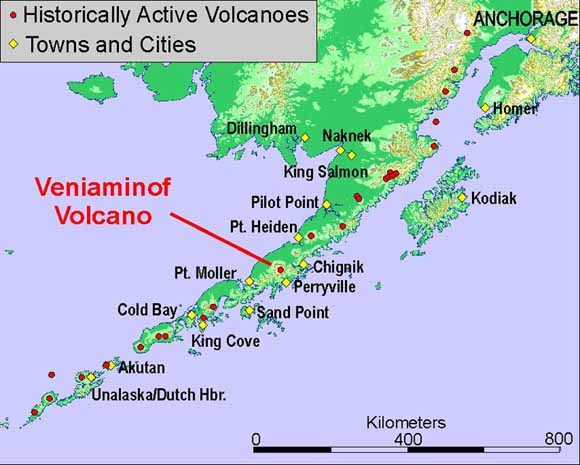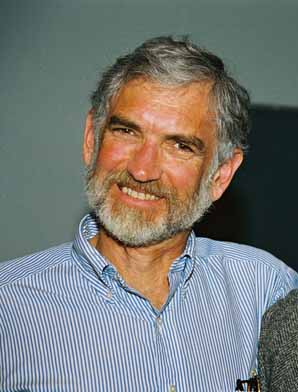
Location: Stanford University
see Map showing Mitchell
Map showing Bloch
This will be the 369th meeting since 1954

Steam rising from the intracaldera cinder cone at Veniaminof volcano in the waning stages of the 1983 to 1984 eruption. Photograph by Betsy Yount.
(From an AGU abstract with Andy Calvert, Chris Nye (ADGGS/AVO), and Tom Sisson)
The eruptive history of Mount Veniaminof, 800 km southwest of Anchorage and one of the largest and most active volcanoes in the Aleutian arc, is being established through geologic mapping with GIS support, supplemented by geochemistry and 40Ar/39Ar and K-Ar geochronology. The Veniaminof edifice has a basal diameter of ~40 km, a volume of ~350 km3, and an 8-km-diameter ice-filled caldera whose wall reaches an elevation of 2500 m. Fracture patterns in glassy lava flow surfaces indicate widespread ice/lava interaction, which resulted in ice-marginal flows and tuyas at lower elevations. Exposures from deep glacial valleys to the caldera rim reveal a long history of dominantly basaltic and basaltic andesitic activity from at least 250,000 to 100,000 yr ago. Silicic magmas vented beginning ~100,000 yr ago are represented by dacite lavas (to 68% SiO2) on the south and west flanks. Similarly, voluminous andesite and dacite were produced as recently as ~35,000 yr ago (andesite) from a northwest-trending set of flank vents. Abundant dikes in caldera and canyon walls follow an arc-normal trend well defined by late Pleistocene northwest flank vents. Other abundant dikes have arc-parallel orientations and were emplaced prior to ~100,000 yr B.P. pre-caldera lavas high on the edifice. Most lava compositions fall in the tholeiitic field on an SiO2 versus FeO/MgO diagram. With the exception of a small volume hornblende dacite lava flow (79,000 yr), no hydrous phenocrysts are known in any Veniaminof juvenile eruptive products. Basalts and basaltic andesites carry olivine and plagioclase phenocrysts, the latter commonly to over 1 cm, joined by augite in some crystal-rich lavas. Andesites and dacites typically have few, small phenocrysts of plagioclase, augite, and low-Ca pyroxene ± Fe-Ti oxide. Caldera collapse may have initiated in the Pleistocene with eruption of dacitic magma locally preserved as pumiceous pyroclastic-flow and -fall deposits on the west side of Veniaminof and capped by basaltic andesitic lava dated at 28,000 yr B.P. Although the caldera may have collapsed further during two large Holocene andesitic explosive eruptions, eroded 33,000-yr-old lava displaying ice-contact jointing drapes the caldera wall and indicates that a caldera was present in the late Pleistocene. The youngest dated Veniaminof lavas on the south, ice-blanketed side of the caldera are ~50 ka; a few south flank cinder cones may be latest Pleistocene/early Holocene. Despite the absence of an exposed southern caldera wall, no debris-avalanche-deposit evidence has been found for an alternative, sector-collapse origin of the caldera structure. Two voluminous andesitic Holocene pyroclastic eruptions (3700 yr BP and >4700 yr BP) emplaced pyroclastic-flow deposits on Veniaminof's flanks and in surrounding valleys. The younger deposited lithic breccia at higher elevations, including plutonic clasts with textures ranging from coarse-grained cumulate gabbro to medium-to-fine-grained miarolytic hornblende granodiorite compositionally like Veniaminof dacite. A still younger, widespread dacitic (63.5% SiO2) pumice-fall deposit up to ~30 cm thick suggests that this long-lived magmatic system may produce explosive silicic eruptions in addition to the historically-known basaltic andesitic strombolian and effusive eruptions from the intracaldera cone that is currently ejecting ash. See http://www.avo.alaska.edu/avo4/atlas/volc/venia/veni2004/index.htm. For ten more photos of the volcano see http://geopubs.wr.usgs.gov/dds/dds-40/album.html#17.

Charlie Bacon is a Research Geologist at the U.S. Geological Survey in the Volcano Hazards Team. He earned his BS in Geology at Stanford in 1970 and his Ph.D. in Geology from Univ. of California, Berkeley in 1975. His current research interests include Physical volcanology, petrology, geochemistry, and eruptive histories of calderas, emphasizing detailed study of Crater Lake, Oregon, and Veniaminof and Aniakchak calderas, Alaska Peninsula. General interest in volcanic and magmatic processes. Secondary Ion Mass Spectrometry applied to geologic and biologic materials. Read more about Charlie on the SHRIMP web site.

Charlie Bacon
Reservations: The preferred way to make reservations is simply to email Janice Sellers at janice@seismosoc.org by Feb. 4, tell her you will attend, commit to pay, and bring your payment to the meeting. Janice always emails a confirmation; if you don't get one, assume email crashed yet again and email her a second time. A check made to "PGS" is preferred, payable at the meeting.
If you want to pay in advance:
Stanford faculty and students: Please make dinner reservations by Feb. 4. Contact Dr. Juhn Liou via his mailbox (and leave check), Geological and Environmental Sciences Office, Geocorner - Bldg. 320 (Rm. 118). Make checks out to "PGS."
All others, including faculty and students from other Bay Area universities and colleges and USGS: Please make dinner reservations by Feb. 4. Contact Janice Sellers, at Seismological Society of America, 201 Plaza Professional Building, El Cerrito, CA 94530, phone (510) 559-1780. Send check made out to "PGS" to Janice.
Dinner is $30.00. Includes wine (5:30 to 6:15 PM.) and dinner (6:15-7:30 PM.).
For students from all universities and colleges, the dinner, including the social 3/4-hour, is $5.00 and is partially subsidized thanks to the School of Earth Sciences, Stanford University (Note, no-show reservations owe the full price).
Doris, whose wonderful crew prepares our meals, asked that we let you know that people who are late RSVP'ing and people who show up without a reservation will be welcome but that they will be eating on paper plates with plastic utensils (food supply permitting).
Dues for Academic Year 2004-2005 ($10.00) should be sent to Janice Sellers, Seismological Society of America, 201 Plaza Professional Building, El Cerrito, CA 94530. Janice's phone: (510) 559-1780.
Officers: Cheryl Smith, President; Mike Diggles, Vice President; Vicki Langenheim, Secretary; Janice Sellers, Treasurer; Adina Paytan, Field-Trip Czarina

Date created: Tuesday, January 25, 2005
Last modified: Tuesday, February 24, 2005
Created by: Mike Diggles, Vice President, PGS.